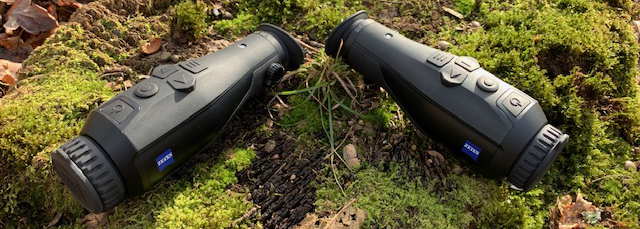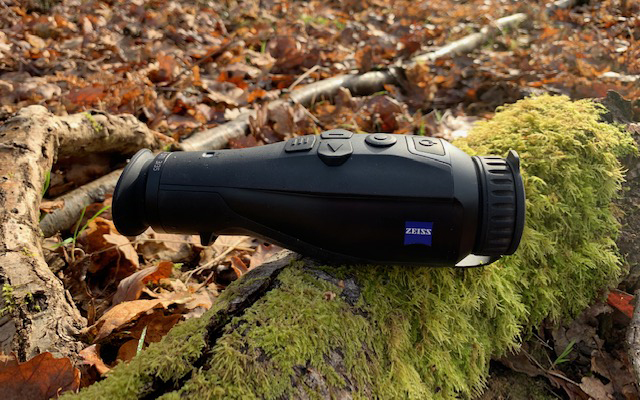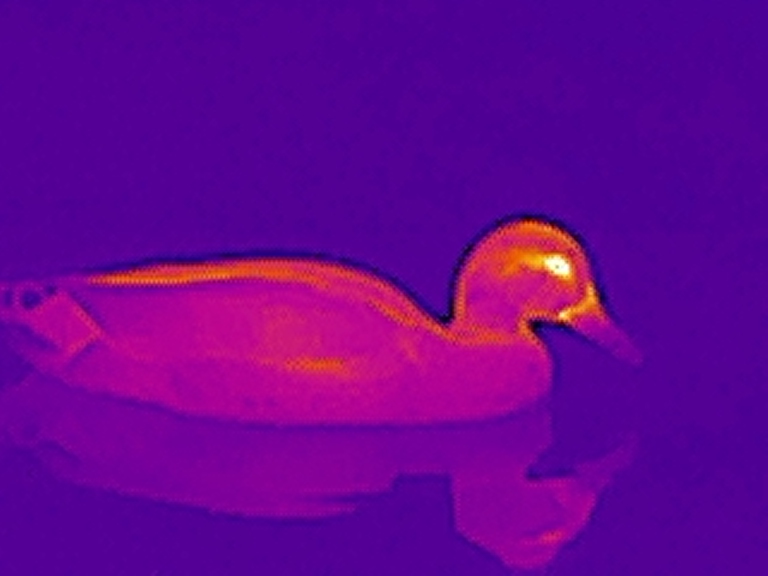In the Field – Zeiss DTI 3/35 and 3/25 Thermal Imaging Cameras

The ability to observe birds (and other wildlife) in the dark opens up all manner of possibilities. For example, the band of trees which overlooks my garden regularly plays host to Tawny Owls. I know this because we hear them (both male and female) calling on a regular basis. Many’s the time I’ve stood in the garden listening to an owl calling, unseen, no more than twenty meters away and, inevitably, have found myself wishing for the ability to see into the darkness. Just imagine how great that would be!
Well, that dream has now taken a significant step towards becoming reality because, courtesy of the kind folk at Zeiss UK, in early February this year I found myself in temporary possession of two of the company’s DTI 3 Thermal Imaging Cameras: the Zeiss DTI 3/35 and DTI 3/25.
What is a DTI Camera?
DTI – Digital Thermal Imaging. These cameras are designed for nighttime viewings and other light-limited times such as dawn and dusk. They specifically highlight subjects based on their heat levels.

At first glance, a DTI 3 looks like something of a cross between a monocular and a small video camera…which makes sense given that, in a way, that’s pretty much what it is. Here we have a product that can be used for locating and observing wildlife (both day and night) but which also has the ability and flexibility to capture video footage and still images by virtue of 15GB of internal memory.
This sets these models apart from some thermal imaging devices which allow observation but don’t have the facility to record images. The 25 and 35 refer to the focal lengths of the respective camera lenses – so 25mm and 35mm. What this means in practice is that the DTI 3/25 will give a wider field of view (ideally suited to woodland) whereas the DTI 3/35 will allow closer views of your subject (ideally suited to more open terrain).
4x Digital Zoom
Both models feature 4x digital zoom which increases in increments of 0.5x with each press of the relevant button and is cyclical, by which I mean that once you’ve got to 4x the next press will take you back to 1x. Zoom settings can be seen via the monitor which is a nice feature. Zeiss quotes range as an impressive 880 metres for the 25mm model and an even more impressive 1235 metres for the 35mm.
Ergonomic Design
In the hand, the two models feel virtually identical. The 35mm version is marginally longer and heavier (by 6mm and 10g) than its stablemate; height and weight are identical for both at 60mm and 65mm respectively.
With regard to ergonomics, the DTIs have been designed for one-handed operation and also to feel comfortable to those of both right-handed and left-handed persuasions. This has been achieved by laying the control buttons out symmetrically on the upper side of the device.
Both units are wider at the sides than at the top and bottom; Zeiss claims that this allows a more natural hand posture which then helps with longer, fatigue-free viewing. Collectively, these features form part of Zeiss’s ‘ErgoControl’ concept and the following photos probably illustrate this better than words:
As the following image shows, the top-mounted control buttons really do facilitate one-handed operation as this is where the user’s fingertips are going to rest when in use. Intelligent positioning, indeed. I didn’t try the DTIs whilst wearing gloves (as the loan period coincided with some surprisingly mild conditions) but the controls appear to be sufficiently chunky and well-spaced to allow this if required.

The only controls which aren’t top-mounted are those which allow for adjustment of focus and diopter. The former is addressed by means of a ring around the objective lens and the latter is controlled by a small rotational adjuster on the side of the body close to the eyecup. I work off a very strong +3 diopter these days and found that both units were able to accommodate this without issue.
Hot Modes for Sharp Shots
Getting back to the camera side of things for a second, both models boast an HD LCOS (High Definition, Liquid Crystal on Silicon) display and a Contrast Enhancement feature which can be activated to maintain contrast and aid viewing in foggy or humid conditions.
I didn’t encounter any fog or humidity during my winter excursions so can’t comment on the effectiveness of the aforementioned feature but it is worth knowing that it’s there.
It’s possible to choose from four colour modes - Black Hot, White Hot, Red Hot and Rainbow – the first two being best for identification, Red Hot is aimed at fast detection of a heat source and the aptly-named Rainbow mode separates different areas depending on temperature thus leading to a multi-coloured image.
Advanced Viewing Options
But that’s not where the clever stuff ends – oh no, not by a long shot. Because, in addition to the quartet of colour modes, the user can also avail themselves of High Frame Rate, Picture-in-Picture, Hot Tracking and Enhanced Camouflage functions. All of these functions are accessed via the internal menu and are easy to activate/deactivate as required.
High Frame Rate is aimed at flicker reduction whereas Picture-in-Picture (PiP) overlays a second, zoomed-in image to help with identification – which sounds like a useful feature when seeking out crepuscular or nocturnal wildlife.
Hot Tracking allows the user to activate a small red square which then homes in on the warmest point within the field of view and is something I found myself using extensively.
Enhanced Camouflage mode doesn’t serve to render the user invisible (sadly) but does switch off the DTI’s LED indicator which, to be fair, goes partway towards invisibility and also helps conserve battery life.
10 Hour Battery Life
On the subject of battery life, both units charge via USB, and Zeiss quotes a typical battery life of 10 hours. I managed to use both units over the course of several evenings without having to recharge so I have no reason to doubt the manufacturer on that front.

Can I use a DTI in daylight?
I should stress at this point that these cameras can be used during daylight as well as at dawn and dusk or at night. The benefits of daytime use might not be immediately apparent but, upon reflection, thermal detection could be extremely useful for picking up anything that might be trying to hide away in cover.
This is something I discovered during my first sortie with the DTIs…more on that story later. I also have it on good authority from one Zeiss aficionado that he was able to deploy the DTI 3/35 to great effect to find several Bitterns hiding in a reedbed so the potential here is significant.
Weather Resistant
It’s worth noting that the DTIs are protected against dust and water ingress to IP66. This is a reassuringly high level of protection so it’s good to know that you’re covered in the event of inclement weather. On top of that, each unit is supplied with a rubber objective cap, a carry case (with shoulder strap) and a neoprene strap. So far so good.
Zeiss DTI in the field
Once I had familiarised myself with the workings of the DTIs I set off into the inky darkness to see how they would perform. Luckily, I live in a rural location and the aforementioned inky darkness begins a mere stone’s throw from the house. Light pollution is low and we’re surrounded by lots of farmland interspersed with hedgerows and some small, scattered areas of woodland so, theoretically, ideal conditions for field testing.

During my first foray, the wildlife proved elusive so I spent some time just flicking through the various colour modes, practising switching between stills mode and video mode (which is easily achieved as it’s all done through one button) and just generally getting used to the DTIs.
As the controls are identical on both models, once you’ve sussed one unit out you can switch straight to the other very quickly and easily. I can confirm that both models are very easy to use one-handed, the only time I really felt the need to use the other hand was when I wanted to adjust the focus ring.
I found out very quickly that the DTIs definitely live up to Zeiss’s claims with regard to ambidexterity. I’m right-handed but my left eye is much stronger than my right so, after starting off in right-hand/right-eye mode I switched over to left-hand/left-eye and can confirm that the symmetrical layout of the control buttons is suitable for left-handed and right-handed users.
Switching through the modes is just like switching through the 0.5x zoom increments, one button cycles through the four colour modes in turn, returning to the first mode once you’ve made your way through the list.

I discovered that I really liked Black Hot mode for general observation and Red Hot mode for scanning/detection. That’s not to take anything away from White Hot and Rainbow modes, you understand, but I suspect that there may be an element of personal taste here and Black Hot and Red Hot were the ones I found myself using most.
As I said, wildlife was thin on the ground during my first outing but, on my way home I stopped to take a final scan with the DTI 3/35 in Red Hot mode and detected a single, small but very definite heat source in the hedgerow further up the lane. With the addition of some digital zoom I was able to discern that said heat source was in fact a roosting Blackbird. Without the DTI I would have had no idea at all that the bird was there – this was around 8pm in February – so this minor find served as a perfect illustration of just how useful thermal imaging can be.
Further into the foray
On the next two outings, I made a point of swapping regularly between the two models. The DTI 3/25 definitely has a noticeably wider field of view whilst the extra reach of the DTI 3/35 was readily apparent.
For me, the most immediate advantage of both was the ability to locate creatures which would otherwise have gone undetected under the cloak of darkness. A Muntjac feeding on the far side of an open field and a fox foraging at the woodland edge were detected using 3/25 and 3/35 respectively, at a rough distance of 200 metres and 150 metres.
A group of faint ‘heat spots’ in a dense thicket resolved themselves into roosting Wood Pigeons following a stealthy approach and a now habitual switch from Red Hot to Black Hot modes.
The perfect birding companion
One thing to make clear at this point is that the DTI 3s won’t give you broadcast quality photos or video footage at these distances but what they do – and for me, this is the crucial thing – is allow you to locate, identify and observe wildlife even when you’d struggle to see your hand in front of your face.
As a birder, I typically venture into the field carrying binoculars and a spotting scope and I know that most other birders do the same. Add either of the DTI 3s to your armoury and you’re good to bird 24 hours a day! If nighttime birding isn’t your thing then you can still use your chosen DTI to reveal the presence of those elusive species which have a talent for hiding themselves away even in daylight – which tends to be quite a few of them, I find.
So, what did I see? Examples from in camera
On my final jaunt, I captured the following video grabs. These feature some Mallards and illustrate White Hot and Black Hot modes respectively. Taken with DTI 3/35
And this close bird is shown in Rainbow mode. Taken with DTI 3/25.

Images and video grabs can be downloaded directly onto a laptop (as mine were) via USB. It’s also possible to link your smartphone to your DTI via the Zeiss Hunting app. I understand that the company is in the process of developing a dedicated Nature app which is likely to be of interest to many.
I can confirm that my smartphone linked to both DTIs very quickly and easily; the benefit of this is that it allows live streaming onto the phone and also has great potential for image sharing. The great advantage of being able to live stream is that it allows more than one observer to see what the DTI is seeing at the same time and sharing is caring, as the saying goes!
Going in my pocket!
In conclusion, what we have here are two very interesting and genuinely useful thermal imaging cameras which do exactly what they say on the tin. The DTI 3s have the potential to be real game changers for anyone with a keen interest in wildlife observation, particularly for those hardy souls who like to be in the field day and night.
Having the ability to locate and then reliably identify a target at any time has to be a real game changer. Both models strike me as the type of products which, once purchased, would very quickly find themselves accompanying their lucky owner on every trip into the great outdoors. The only downside? Those Tawny Owls still elude me!
So, all that remains is for me to say thank you for reading, I hope you’ve found this information useful and, as always, Happy Birding!
Where can I find out more?
You can find the Zeiss DTI Thermal Imaging Camera here:
Read next
- Zeiss SFL Binocular Review at the Somerset Levels
- Birding From Home with Martin Drew
- Raven and Skye: A Tale of Two Campervans, Birding and Stargazing
Thank you!
Thanks for taking the time to read our blog, we really do hope they help you out and answer some of your questions. If you still have some unanswered, then please feel free to get in touch with our team of experts.
We have a LiveChat option on our website and we can, of course, be contacted via our email, we're also on the end of the phone too! Read more on how to contact us here >
Want to write for us?
If you've got experience with producing content on photo, video and/or optics products or techniques then we would love to hear from you. Contact our blog editor, Bea, with a sample of your work at [email protected].
- By Martin Drew
- 3 Mar 2023





































































